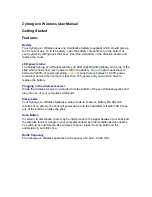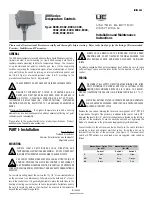
HEAD OFFICE
: TOKYO BUILDING, 2-7-3 MARUNOUCHI, CHIYODA-KU, TOKYO 100-8310, JAPAN
HIMEJI WORKS : 840, CHIYODA CHO, HIMEJI, JAPAN
This manual confers no industrial property rights or any rights of any other kind, nor does it confer any
patent licenses. Mitsubishi Electric Corporation cannot be held responsible for any problems involving
industrial property rights which may occur as a result of using the contents noted in this manual.
6. ALLOCATION OF BUFFER MEMORIES (BFM)
6.1 Buffer memories
The FX
2N
-4AD-PT communicates
with the PLC via buffer memories.
BFMs (buffer memories) #21 to #27
and #31 are reserved.
All BFM data can be read by the
PLC using the FROM instruction.
P L C c a n r e a d / w r i t e t h e B F M s
(marked with “*” ), using FROM /TO
instructions.
1) BFM #0 value (K0 or K1) decides the Pt100 characteristic to be used.
K0 : JIS C 1604-1997
K1 : JIS C 1604-1981
2) The number of samples to be averaged are assigned in BFMs #1 to #4. Only the range 1 to 4096 is
valid. Values outside this range are ignored. The default value of 8 is used.
3) A number of recently converted readings are averaged to give a smoother read out. The averaged
data is stored in BFMs #5 to #8 and #13 to #16.
4) BFMs #9 to #12 and #17 to #20 store the current value of the input data. This value is in units of 0.1
°
C
or 0.1
°
F, but the resolution is only 0.2
°
C to 0.3
°
C or 0.36
°
F to 0.54
°
F.
6.2 Status Information
1) Buffer Memory BFM #28: Digital range error latch
BFM #29 b10(digital range error) is used to judge whether the measured temperature is within the
unit’s range or not.
BFM #28 latches the error status of each channel.
Low : Latches ON when the temperature measurement data drops below the lowest
temperature measurement limit.
High
: Turns ON when the temperature measurement data rises above the highest
temperature measurement limit.
When an error occurs the temperature data before the error is latched. If the measured value returns
to within valid limits the temperature data returns to normal operation. (Note: The error remains
latched in (BFM #28))
An error can be cleared by writing K0 to BFM #28 using the TO instruction or turning off the power.
2) Buffer Memory BFM #29: Error status
3) Buffer Memory BFM #30: Identification Code
The identification code or ID number for this Special Block is read from buffer memory BFM #30 using
the FROM instruction. This number for the FX
2N
-4AD-PT unit is K2040.
The PLC can use this facility in its program to identify the special block before commencing data
transfer from and to the special block.
b15 or b8
b7
b6
b5
b4
b3
b2
b1
b0
Not used
High
Low
High
Low
High
Low
High
Low
CH4
CH3
CH2
CH1
Bit devices of BFM #29
ON
OFF
b0 : Error
When either b2 or b3 is ON
A/D conversion is stopped for
the error channel.
No error
b1 : Reserved
Reserved
Reserved
b2 : Power source
24V DC power supply failure.
Power supply normal
b3 : Hardware error
A/D converter or other
hardware failure.
Hardware Normal
b4 to b9 : Reserved
Reserved
Reserved
b10 : Digital range error
Digital output/analog input
value is outside the specified
range.
Digital output value is normal.
b11 : Averaging error
Selected number of averaged
results is outside the available
range -see BFM #1 to #4
Averaging is normal.
(between 1 to 4096)
b12 to b15 : Reserved
Reserved
Reserved
BFM
CONTENTS
*#0
Characteristic change
*# 1 - #4
CH1 to CH4 Averaged temperature reading to be
averaged (1 to 256) Default = 8
#5 - #8
CH1 to CH4 Averaged temperature in 0.1
°
C units
#9 - #12
CH1 to CH4 Present temperature in 0.1
°
C units
#13 - #16
CH1 to CH4 Averaged temperature in 0.1
°
F units
#17 - #20
CH1 to CH4 Present temperature in 0.1
°
F units
#21 - #27
Reserved
*#28
Digital range error latch
#29
Error status
#30
Identification code K2040
#31
Reserved
7. SYSTEM BLOCK DIAGRAM
8. EXAMPLE PROGRAM
In the program shown below, the FX
2N
-4AD-PT block occupies the position of special block number 2 (that
is the third closest block to the PLC). The averaging amount is four. The averaged values in degrees C of
input channels CH1 to CH4 are stored respectively in data registers D0 to D3.
Multiplexer
CPU
System
ROM
Buffer
Memory
RAM
A/D
converter
PLC
Command
information
write and
data status
read
24V DC
Power Source
5V Power
Supply
POWER
LED
Photocoupler
±15V
CH1
CH2
CH3
CH4
A/D
LED
Cyclic switching
FX
2N
-4AD-PT Analog Block
DC/DC
converter
Gain and offset
values are
stored in the
EEPROM
Control
signals
Converted
data
5V
24V
LED
FROM
TO
Analog Input
5V
M1
or
M8000
K2 K1 K4 K4
FNC79
TO
K2 K5 D0 K4
FNC78
FROM
K2 K9 D0 K4
FNC78
FROM
special
block No.2
FX
2N
-4AD-PT
BFM number
result
destination
No. of
words read
Block No.2 BFM #30
→
(D10)
Identification code
This initial step checks that the special function block placed at position 2 is
actually an FX
2N
-4AD-PT, i.e. its unit identification number is 2040 (BFM #30).
This step is optional, but it provides a software check that the system has been
configured correctly.
This step provides optional monitoring of the FX
2N
-4AD-PT Error Buffer Memory
(#29). If there is an Error on the FX
2N
-4AD-PT, bit b0 of BFM #29 will be set on.
This can be read by this program step, and output as a bit device in the PLC (Y010 in
this example). Additional Error devices can be output in a similar manner, i.e. b10 BFM
#29. (see below)
M8002
Initiali-
zation
Pulse
K2 K30 D10 K1
FNC78
FROM
K2040 D10 M0
FNC10
CMP
When (K2040) = (D10), M1 = ON
i.e. When identification code is K2040, M1 = ON
Y010
M8000
RUN
monitor
K2 K29 K4M10 K1
FNC78
FROM
M10
Block No.2 BFM #29
→
(K4M10)
Transfer the error status to (M25 to M10).
When error is found, M10 = ON.
Represents b0 BFM #29
Y010
M8000
K2 K29 K4M10 K1
FNC78
FROM
M10
Y011
M20
Represents b0 BFM #29
Represents b10 BFM #29
(K4)
→
(BFM #1 to #4)
Number of samples is changed to four on CH1 to CH4.
(BFM #5 to #8)
→
(D0 to D3)
Transfer the averaged temperature value in °C to the
data registers.
This step is the actual reading of the FX
2N
-4AD-PT input channels. It is essentially
the only program step which is needed. The "TO" instruction in this example, sets
the input channels, CH1 to CH4, to take the average reading of four samples.
The "FROM" instruction reads the average temperatures (BFM #5 to #8) for input
channels CH1 to CH4 of the FX
2N
-4AD-PT. If direct temperature readings are
required BFM #9 to #12 should be read instead, ex.
9. DIAGNOSTICS
9.1 Preliminary checks
I.
Check whether the input/output wiring and/or extension cables are properly connected on the FX
2N
-
4AD-PT analog special function block.
II.
Check that the PLC system configuration limits have not been exceeded, i.e. the number of special
function blocks, and the total system I/O are within the specified range.
III. Ensure that the correct operating range has been selected for the application.
IV. Check that there is no power overload on either the 5V or 24V power sources, remember the loading
on main unit or a powered extension unit varies according to the number of extension blocks or
special function blocks connected.
V.
Make sure that the main unit has been switched to RUN.
9.2 Error checking
If the FX
2N
-4AD-PT special function block does not seem to operate normally, check the following items.
•
Check the status of the POWER LED.
Lit
:The extension cable is properly connected.
Otherwise :Check the connection of the extension cable.
•
Check the external wiring.
•
Check the status of the “24V” LED (top right corner of the FX
2N
-4AD-PT).
Lit
:FX
2N
-4AD-PT is ON, 24V DC power source is ON.
Otherwise :Possible 24V DC power failure, if ON possible FX
2N
-4AD-PT failure.
•
Check the status of the “A/D” LED (top right corner of the FX
2N
-4AD-PT).
Lit
:A/D conversion is proceeding normally.
Otherwise :Check buffer memory #29 (error status). If any bits (b0, b2, b3) are ON, then this is why
the A/D LED is OFF.
10.EMC CONSIDERATIONS
Electromagnetic compatibility or EMC must be considered before using the FX
2N
-4AD-PT.
Mitsubishi recommend that the PT 100 sensors used, should be fitted with a form of seild or screening as
protection against EMC noise.
If some form of cable protection is used, the “Shield” must be terminated at the
terminals
as shown in section 4.1.
Because of the delicate nature of all analog signals, failure to take good EMC precautions could lead to
EMC noise induced errors; up to ±10% of actual values. This is an absolute worst case figure, users who
do take good precautions can expect operation within normal tolerances.
EMC considerations should include selection of good quality cables, good routing of those cables away
from potential noise sources.
Additionally it is recommended that signal averaging is used as this will reduce the effects of random noise
“spikes”.
FG
Manual number : JY992D65601
Manual revision : E
Date
: September 2007


























